Are you wondering how to set up and install a WordPress multisite network? WordPress has a built-in capability to create multiple websites using a single WordPress installation.
A WordPress multisite network is often used by blogs, schools, and businesses that need to run separate websites but want to manage them under one dashboard.
In this article, we will show you how to install and set up a WordPress multisite network properly.
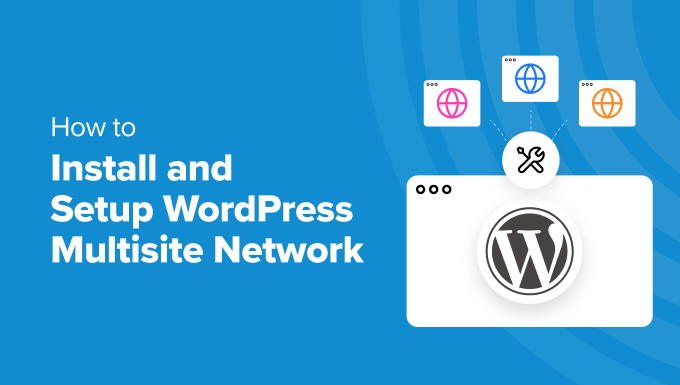
Since this is a comprehensive article, we have added this table of contents for easier navigation. You can use the quick links below to jump to the section you want to learn about:
WordPress Multisite Basics
- What Is WordPress Multisite?
- Pros of Using a WordPress Multisite Network
- Cons of Using a WordPress Multisite Network
- Who Needs a WordPress Multisite Network?
WordPress Multisite Installation and Setup
- Requirements for a WordPress Multisite Network
- Choosing a Domain Structure for Your Multisite Network
- Setting Up Wildcard Subdomains
- Setting Up Custom Domain for WordPress Multisite
- Enabling WordPress Multisite Network Feature
- Setting Up Your WordPress Multisite Network
WordPress Multisite Configuration Settings
- Configuring Network Settings
- Opening Your Multisite Network for Registrations
- New Site Settings
- Upload Settings for Your Multisite Network
- Plugin Menu Settings
Setting Up Default Content, Theme, and Plugins
- Adding New Sites to Your WordPress Multisite Network
- Adding Themes and Plugins to Your Multisite Network
- Adding Default Content to New Sites
Troubleshooting and FAQs
What Is WordPress Multisite Network?
A WordPress multisite network allows you to run and manage multiple WordPress blogs or websites from a single WordPress installation.
It enables you to create new sites instantly and manage them using the same username and password. You can even allow other users to sign up and create their blogs or websites on your domain.
The WordPress multisite network comes with advanced settings that you can use to customize each website/blog on your network.
Pros of Using a WordPress Multisite Network
In many situations, a WordPress multisite network can be more useful than managing multiple standalone WordPress sites. Here are some of the advantages of using a WordPress multisite network:
- As the network administrator, you can easily manage multiple sites from a single dashboard.
- Each site on the network can have its admin users. The site admins will have the capability to manage only their website.
- You can install plugins/themes and activate them for multiple sites with one download.
- A multisite network also makes it easier for you to manage updates. You only need to update your WordPress, plugins, or themes on one “master” install.
Cons of Using a WordPress Multisite Network
Creating a WordPress multisite network is not always helpful for managing multiple sites.
Here are some of the disadvantages that you should keep in mind before setting up a multisite network.
- All sites on the network share the same resources. This means that when your network is down, all other sites also go down.
- It’s difficult for beginner-level users to manage traffic and server resources. If one of your websites gets unexpected traffic, it will affect all other websites on the network.
- If one website gets hacked, all sites on your network get hacked.
- Some WordPress plugins may not work well on a multisite network.
- WordPress multisite network is not adequately supported by all web hosting providers, which limits your options. We will talk more about this later in the article.
Who Needs a WordPress Multisite Network?
Just because you manage multiple WordPress websites does not mean you need to start using a multisite network.
There are third-party tools to manage multiple WordPress sites from a single dashboard. Tools like InfiniteWP or SolidWP (formerly iThemes) make it easier to maintain multiple WordPress sites under one roof without switching back and forth from one site to another.
Here are some scenarios when creating a multisite network makes sense:
- A magazine website with different sections managed by separate teams
- A business website with sub-sites for different locations and branches
- Government or non-profit websites using WordPress multisite for different departments, locations, and regions
- Your network of blogs running on multiple subdomains
- Schools and colleges using multisite for different departments, and blogs, or letting students create their websites on school servers
Requirements for a WordPress Multisite Network
All websites on a WordPress multisite network share the same server resources. This means that the most important thing you will need is good WordPress hosting.
If you are planning on having just a couple of websites with low traffic, then you can probably get away with shared hosting.
However, due to the nature of a multisite network, you will typically need VPS hosting or a dedicated server as your sites grow.
We recommend Bluehost because they offer shared hosting and VPS/Dedicated servers. They are also one of the official WordPress hosting partners.
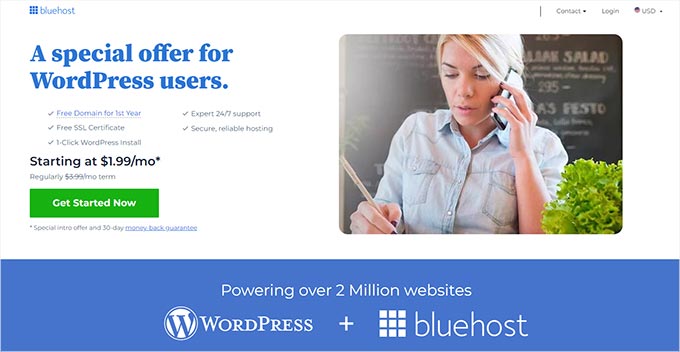
If you’re looking for an alternative, then SiteGround and WP Engine also provide excellent service for WordPress multisite networks.
Apart from web hosting, you will need the basic knowledge of installing WordPress and editing files using FTP.
Choosing a Domain Structure for your Multisite Network
On a WordPress multisite network, you can add new sites using either subdomains or sub-directories.
Example of subdomain:
http://site1.example.com
Example of sub-directory:
http://example.com/site1/
If you choose subdomains, then you’ll have to configure wildcard subdomains on your server. We will show you how to do that in the next step.
On the other hand, if you choose sub-directories or path-based URLs for sites on your network, you can skip the next step.
Setting Up Wildcard Subdomains
Wildcard subdomains create a placeholder subdomain under your domain name. This placeholder subdomain can then be used to map subdomains that you haven’t already defined.
This setting enables WordPress multisite to create new sites using their own subdomains.
If you decide to use subdomains for websites on your multisite network, then you will need to set up wildcard subdomains.
We will show you how to do that on Bluehost. However, the basic process is the same for all hosting providers.
First, you need to log in to your WordPress hosting account’s dashboard. Locate your site under Websites and click on the ‘Settings’ button.
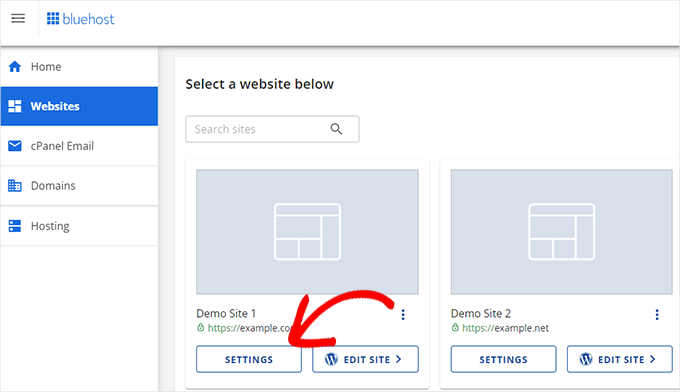
This will open your site’s Settings page, where you need to switch to the ‘Advanced’ tab.
From there, scroll down to the cPanel section and click the ‘Manage’ button.
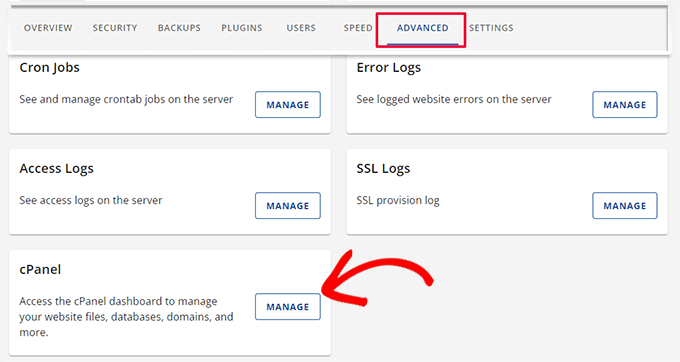
This will launch the cPanel dashboard.
Now, scroll down to the Domains section and click ‘Domains’.
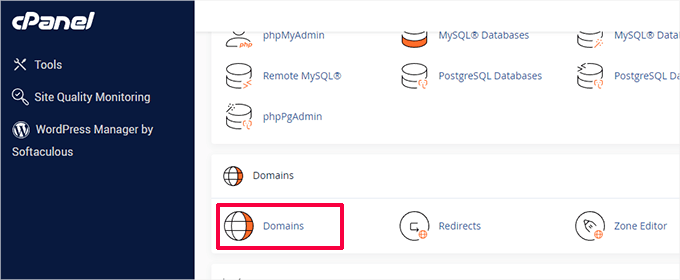
It will then show you a list of domains and subdomains on your hosting account.
You need to click the ‘Create A New Domain’ button to continue.
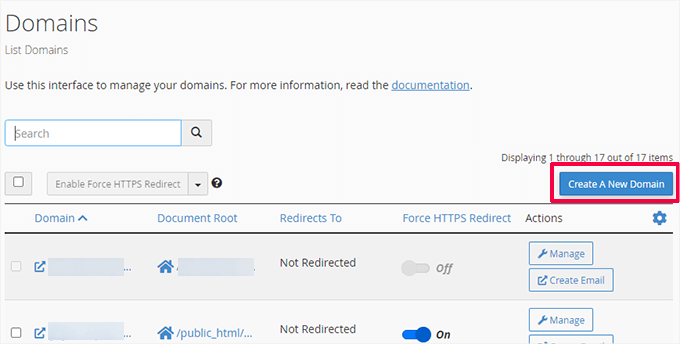
On the next screen, you need to add a wildcard subdomain under the Domain field.
A wildcard subdomain contains an asterisk sign followed by a dot and your domain name. Like this:
*.example.com
Don’t forget to replace example.com with your own domain name.
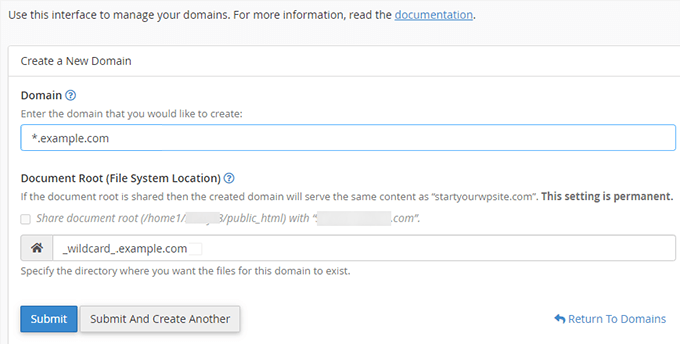
The document root field will be automatically filled to match the wildcard.
Just click the ‘Submit’ button to save your domain settings.
Your hosting account is now ready to support WordPress multisite with subdomains.
Setting Up Custom Domains for Each Site
WordPress multisite also allows you to set different domains for each website in your multisite network.
To set up custom domains, you will need to use the domain mapping feature and update nameserver records in your domain registrar account.
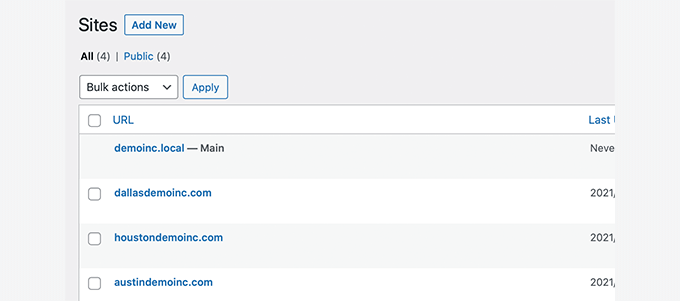
We have created a detailed step-by-step guide on how to create WordPress multisite with different domains with the setup instructions.
Enabling the WordPress Multisite Network Feature
The multisite network feature comes built-in with each WordPress installation. All you need to do is install and set up WordPress like you normally would.
After that, you just need to enable the multisite feature. You can also enable the multisite feature on any existing WordPress site.
Before you enable multisite, don’t forget to create a complete backup of your WordPress site.
Then, connect to your site using an FTP client or cPanel file manager, and open the wp-config.php file for editing.
You need to add the following code to your wp-config.php file just before the /* That’s all, stop editing! Happy publishing. */ line:
/* Multisite */
define( 'WP_ALLOW_MULTISITE', true );
Once that’s done, you can save and upload your wp-config.php file to the server.
This code simply enables the multisite feature on your WordPress site. Once enabled, you will still need to set up the multisite network.
Setting Up Your WordPress Multisite Network
Now that you have successfully enabled the multisite network feature on your WordPress site, it is time to set up the network.
If you are setting up a multisite network on an existing WordPress website, then you will need to deactivate all plugins on your site.
Simply visit the Plugins » Installed Plugins page and select all plugins. You need to select ‘Deactivate’ from the ‘Bulk Actions’ dropdown menu and then click on the ‘Apply’ button.
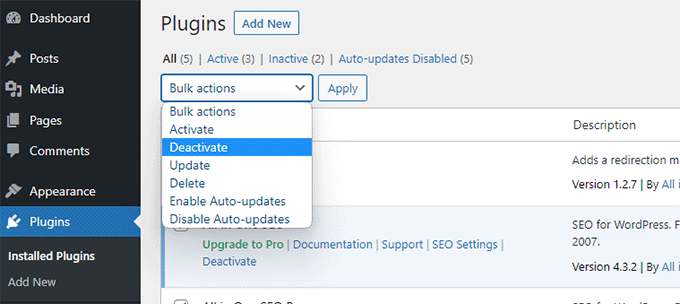
You can now head over to the Tools » Network Setup page.
Here, you can configure your multisite network.
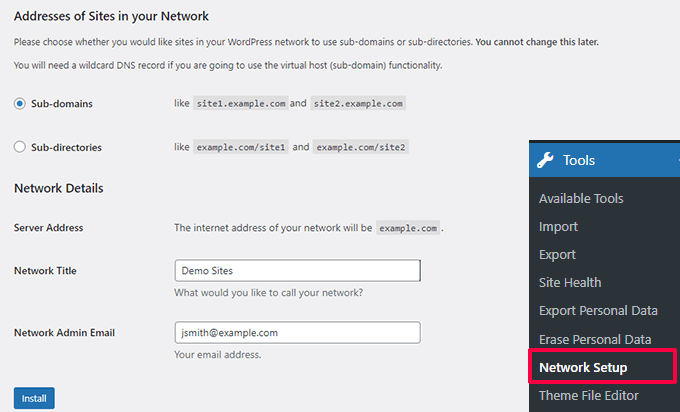
On the network setup screen, you will notice that you need Apache’s mod_rewrite module installed on your server. This module is installed and enabled on all the best WordPress hosting providers.
Next, you need to tell WordPress what domain structure you will be using for sites in your network, e.g., Subdomains or Sub-directories.
After that, you will need to provide a title for your network and ensure the email address in the ‘Network Admin Email’ field is correct.
Click on the ‘Install’ button to continue.
WordPress will now show you some code to add to your wp-config.php and .htaccess files, respectively.
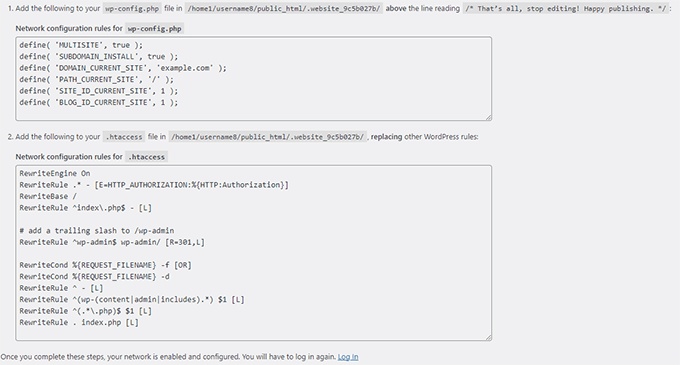
You can use an FTP client or the File Manager in the cPanel to copy and paste the code.
First, edit the wp-config.php file and paste the code just below the line you added in the earlier step.
Secondly, you need to edit the .htaccess file and replace the existing WordPress rules in your .htaccess with the WordPress multisite code you copied.
Don’t forget to save your changes and reupload the edited files back to your server.
Once finished, you will need to re-login to your WordPress site to access the multisite network.
Configuring Network Settings
Now that you have set up the multisite network, it is time to configure its network settings.
Start by logging in to your WordPress website admin area.
After that, you need to switch to the ‘Network Dashboard’ settings to change network settings, add new sites, and configure other settings.
When you take your mouse over to the ‘My Sites’ menu in the admin toolbar, a flydown popup will appear. Click on Network Admin » Dashboard.
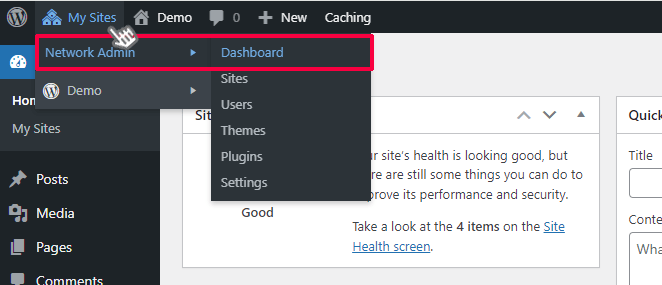
This will take you to the multisite network dashboard. You will notice that there are new menu items to manage your multisite network.
You will also see a ‘Right Now’ dashboard widget that allows you to create a new site and add new users.
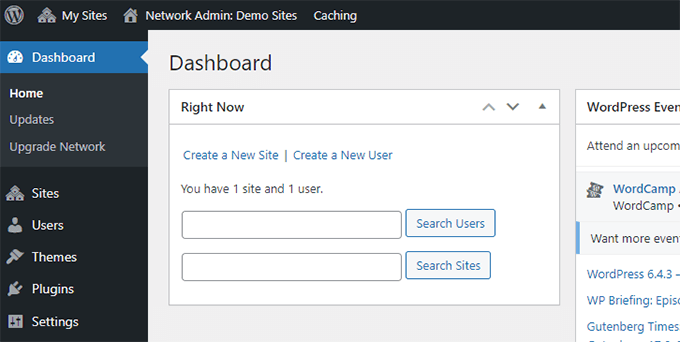
To configure network settings, you just need to click on the ‘Settings’ link in the admin sidebar.
The first option on the network settings page is to set your site title and admin email address. These fields will be filled automatically with the network title and admin email you entered during setup.
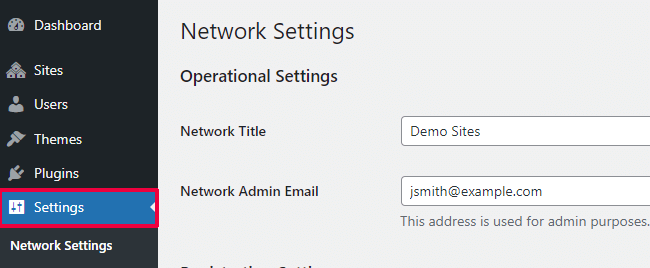
Opening Your Multisite Network for Registrations
The ‘Registration Settings’ section on the network settings page is probably the most important setting in your entire network setup.
By default, both user and site registrations are disabled on the network.
You can choose to open your site for user registration, only allow existing users to create new sites, or allow both user and site registration.
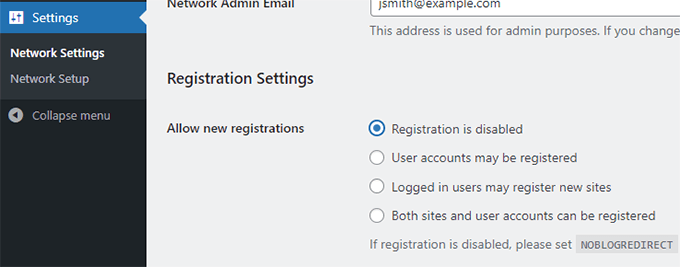
If you are opening your multisite network to registration, then you can check the box next to the ‘Registration Notification’ option.
This will allow you to receive email notifications every time a new user or site is registered.
If you want to allow individual site administrators to add new users to their sites, then you can check the box next to the ‘Add New Users’ option.
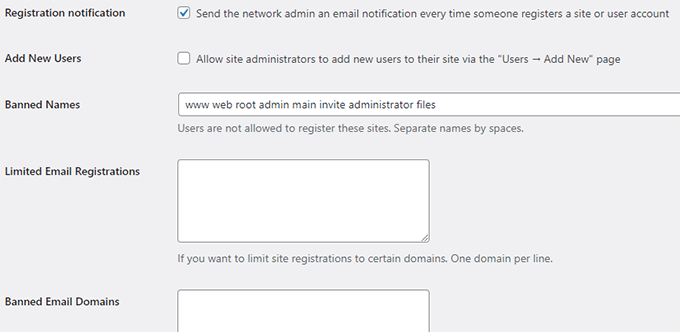
The limited Email Registration option allows you to limit site or user registration to email addresses from specific domains.
This is particularly useful if you only want to allow people from your own organization to register and create users or sites.
Similarly, you can also ban certain domains from registration.
New Site Settings
The ‘New Site Settings’ section allows you to configure default options for new sites created on your multisite network.
You can modify the welcome emails and the contents of the first default post, page, and comment in these settings.
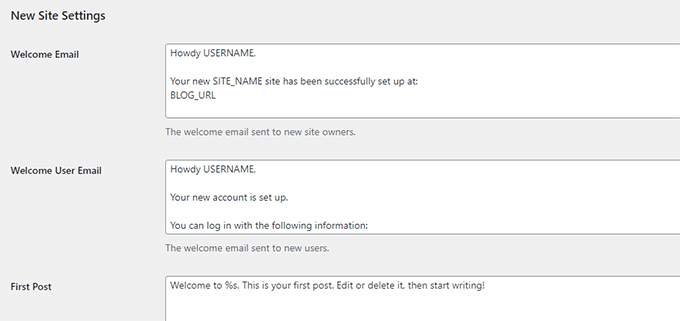
As a network administrator, you can change these settings anytime.
Upload Settings for Your Multisite Network
It is important to keep an eye on the usage of your server resources. Under the ‘Upload Settings’ section, you can limit the total amount of space a site can use for uploads.
The default value is 100 MB, which is probably good for at least 100 photo uploads. You can increase or decrease this space depending on how much disk space you have.
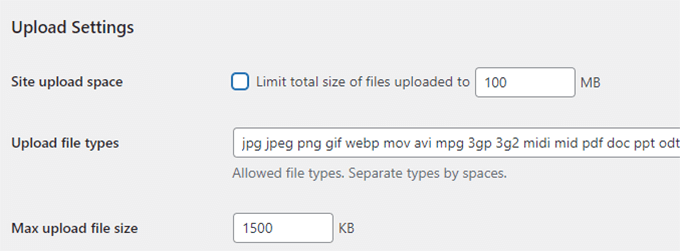
The default upload file types are images, audio, video, and pdf files. You can add additional file types if you want, like doc, docx, odt, and so on.
Afterward, you can choose a file size limit so that users can’t upload insanely large files to the server.
Plugin Menu Settings
Next, you can jump to the Menu Settings. It will allow you to enable the administrative menu for the plugins section on your network sites.

Enabling this will show the Plugins menu to respective site admins. They can activate or deactivate a plugin on their sites, but they cannot install new plugins.
Once you are satisfied with all the configuration settings, go ahead and click the ‘Save Changes’ button.
Adding New Sites to Your WordPress Multisite Network
To add a new site to your WordPress multisite network, simply click on ‘Sites’ under the My Sites » Network Admin menu in the admin toolbar.
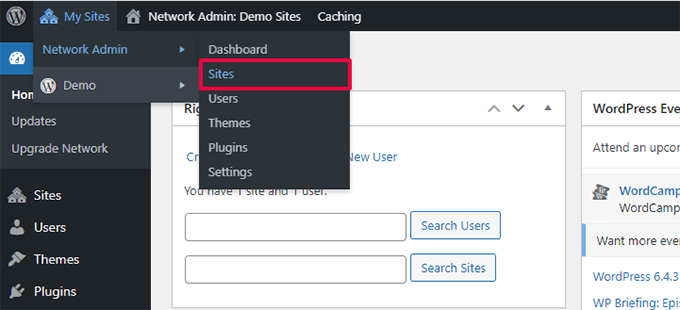
This will show you a list of sites on your current multisite installation. By default, you have your primary site listed as the only site in your WordPress multisite network.
To add a new site, click the ‘Add New’ button at the top.
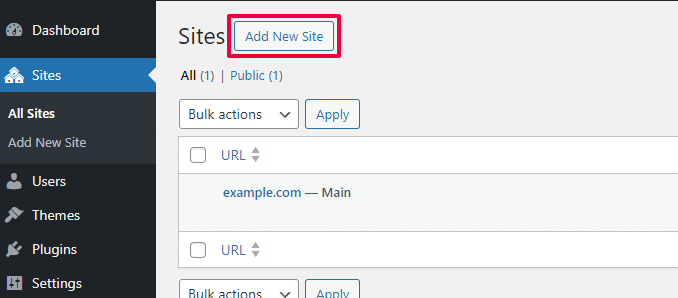
On the ‘Add New Site’ page, provide the site’s address. You don’t need to type the full address, just the part you want to use as the subdomain or sub-directory.
Next, you add a site title and enter the site admin’s email address.
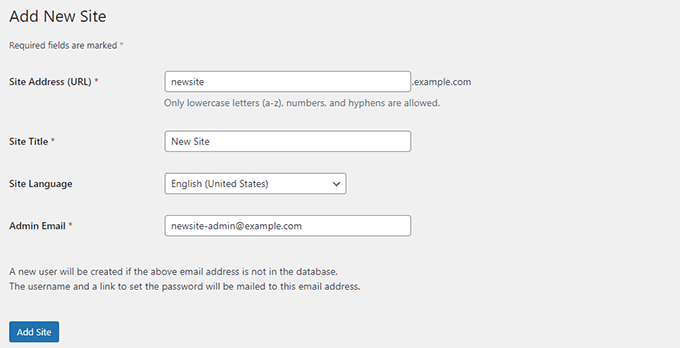
You can add an admin email address other than the one that you are currently using to manage your multisite network.
If another user does not currently use that email address, then WordPress will create a new user and send the username and password to the email address you enter.
Once you are done, simply click on the ‘Add Site’ button.
A new site will be added to your WordPress multisite network. As the network admin, you will also receive a new site registration email.
If you create a new user, that user will receive an email with instructions to set the password and log in.
Adding Themes and Plugins to Your Multisite Network
By default, individual site administrators in a multisite network cannot install themes and plugins on their own.
As the network admin, you can install the respective plugins and themes so they are available for all sites on your network.
Installing Themes for Your Multisite Network
To add themes, go to the My Sites » Network Admin » Themes page.
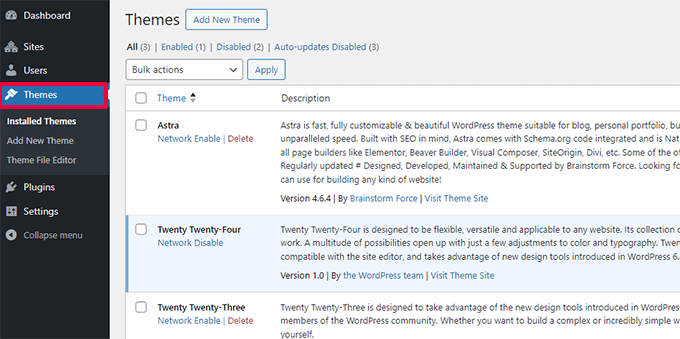
On this page, you will see a list of themes that are currently installed on your WordPress multisite.
You can make a theme available to other sites by clicking on the ‘Network Enable’ option under that theme.
You can also disable a theme by clicking on the ‘Network Disable’ link under the theme. Note: The Network Disable option will only appear when the theme is enabled.
To add a new theme, you need to click on the ‘Add New’ button at the top of your screen and then install a WordPress theme as you would normally do.
Once the new theme is installed, you will be able to make it available to other sites on your network with the ‘Network Enable’ option.
If you need recommendations on which themes to make available to your network, here are our picks of the best WordPress themes that you can use:
- Best free WordPress blog themes
- Best free WordPress photography themes
- Best WordPress multi-purpose themes
Setting a Default Theme for Your Multisite Network
Even if you have added a couple of themes, WordPress will still activate the default WordPress theme for each new site.
If you want to make another theme the default for new sites, then you need to add the following code to your wp-config.php file:
// Setting default theme for new sites
define( 'WP_DEFAULT_THEME', 'your-theme' );
Replace your-theme with the name of your theme. You will need to use the name of the theme’s folder, which you can find by looking at the /wp-content/themes/ folder using FTP or File Manager.
Installing Plugins for Your Multisite Network
Similarly, you can visit the My Sites » Network Admin » Plugins page to install plugins and click on the ‘Network Activate’ link below each plugin to activate it on your multisite network.
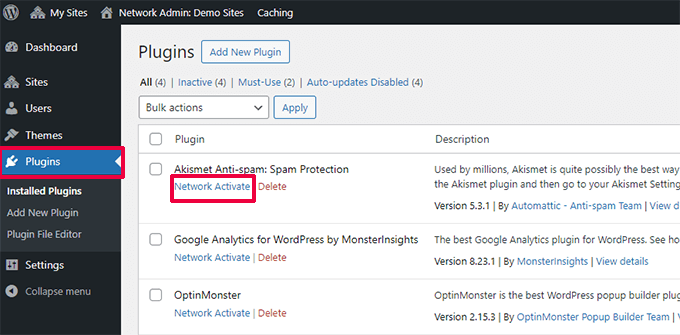
Here are a few essential WordPress plugins that we recommend for every website:
- WPForms – It is the best WordPress contact form plugin that allows you to quickly create beautiful forms using a simple drag-and-drop form builder.
- All in One SEO – It is the most comprehensive WordPress SEO plugin on the market that will help you get more visitors from search engines.
- MonsterInsights – The best Google Analytics solution for WordPress that lets you view traffic data and other helpful reports in your WordPress dashboard.
- SeedProd – Site admins may want to show a coming soon page as they work on their sites. SeedProd allows them to add beautiful coming soon and maintenance mode landing pages.
- WP Mail SMTP – WP Mail SMTP helps you fix the WordPress not sending email issue by using an SMTP server to send crucial multisite registration and notification emails.
For more plugin recommendations, see our list of the essential WordPress plugins for all websites.
Note: If you previously enabled the Plugins Menu option for site admins in the ‘Network Settings’, then the site administrators can activate or deactivate installed plugins on their own. Site admins cannot delete or install a new plugin on their own.
Adding Default Content to Multisite Sites
By default, WordPress allows you to add and edit some default content for each site on your multisite network. You can go to Settings » Network Settings page and add this content in the ‘New site settings’ section.
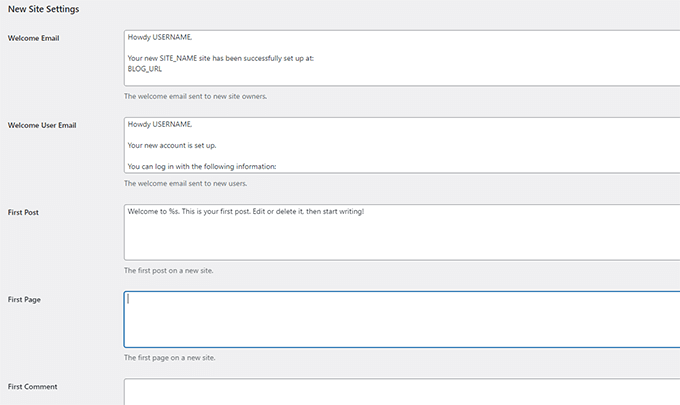
You can edit the content for the default post, page, and comment. We recommend replacing the default content with something more useful for your site admins.
But what if you wanted additional default content to be added to each new site?
By default, WordPress does not give you an option to create additional default content for new sites. If you want to do that, then you will need to add custom code to your WordPress multisite.
In this example, we are going to add a new default page to be created for each new site. You can add this code to your main site’s functions.php file or by using the WPCode plugin on your main site:
add_action('wpmu_new_blog', 'wpb_create_my_pages', 10, 2);
function wpb_create_my_pages($blog_id, $user_id){
switch_to_blog($blog_id);
// create a new page
$page_id = wp_insert_post(array(
'post_title' => 'About',
'post_name' => 'about',
'post_content' => 'This is an about page. You can use it to introduce yourself to your readers or you can simply delete it.',
'post_status' => 'publish',
'post_author' => $user_id, // or "1" (super-admin?)
'post_type' => 'page',
'menu_order' => 1,
'comment_status' => 'closed',
'ping_status' => 'closed',
));
restore_current_blog();
}
You can use the same code with little modifications to create default posts for new sites. Check out the following code:
add_action('wpmu_new_blog', 'wpb_create_my_pages', 10, 2);
function wpb_create_my_pages($blog_id, $user_id){
switch_to_blog($blog_id);
// create a new page
$page_id = wp_insert_post(array(
'post_title' => 'A sample blog post',
'post_name' => 'sample-blog-post',
'post_content' => 'This is just another sample blog post. Feel free to delete it.',
'post_status' => 'publish',
'post_author' => $user_id, // or "1" (super-admin?)
'post_type' => 'post',
));
restore_current_blog();
}
Troubleshooting WordPress Multisite Issues
Most common issues with WordPress multisite network setup happen due to the incorrect configuration of wildcard subdomains and domain mapping issues. Make sure that your web host supports wildcard subdomains before setting up multisite.
The following are some other common issues and their quick fixes.
Fixing Login Issues on Multisite Installs
A common issue is that when using WordPress multisite with sub-directories, some users are unable to log in to the admin area of their sites after they add the required code in the wp-config.php file.
To fix this, locate the following line in the wp-config.php file:
define('SUBDOMAIN_INSTALL', false);
Now, simply replace it with the following line:
define('SUBDOMAIN_INSTALL', 'false');
Find Unconfirmed Users
Another issue you may encounter is not being able to find users who registered on your network but didn’t get the activation email.
To fix this issue, see our guide on how to find pending unconfirmed users in WordPress.
Exporting a Site From Multisite to Its Own WordPress Install
Later, you or another site owner may want to export a site from multisite to a separate WordPress install. This can be easily done. For step-by-step instructions see our guide on how to move a site from WordPress multisite to single install.
You may also want to bookmark our ultimate guide to common WordPress errors and how to fix them. This will save you a lot of time fixing the most common WordPress issues quickly.
FAQs About WordPress Multisite Network
Many of our users have asked us plenty of questions about WordPress multisite network and how to use it more efficiently. The following are the most frequently asked questions that we have answered.
1. Would I be able to better manage my sites with a multisite network?
To be honest, the answer really depends on your usage scenario.
For example, if your websites are not related to each other, then you would be better off with a multiple site management tool like InifiteWP.
However, if you manage multiple sites for a restaurant chain, university, or online magazine, then WordPress multisite will be more efficient.
2. Does WordPress multisite make my websites load faster?
Once again, it depends on several factors. Better WordPress hosting with plenty of server resources will allow multisite to be faster, but then again, with these resources, individual WordPress sites will also run faster.
However, on a shared hosting account, traffic spikes will increase memory usage and slow down all websites on the multisite network at the same time. To improve multisite speed, see our guide on WordPress performance and speed optimization.
3. Can I add an online store to a WordPress Multisite Website?
Yes, you can add an online store in the WordPress multisite network. Most likely, you will be using an eCommerce plugin like WooCommerce for that, which is compatible with WordPress multisite.
4. Can I install ‘x plugin’ on my WordPress multisite?
Some WordPress plugins may not be compatible with WordPress multisite. Normally, plugin authors mention it on the plugin’s website, and you can avoid installing a plugin that may not work on a multisite setup. However, if it is not mentioned, then it is safe to assume that it is multisite compatible.
5. How do I share user logins and roles across the multisite network?
By default, a user who is registered on one site cannot register or be added to another site on the same network. That’s because they are already registered in the shared WordPress database. However, they don’t have any user role privileges on other sites.
You can use third-party plugins like WP Multisite User Sync to sync users across the network. However, you need to be careful, as you may end up giving someone admin privileges to a site.
We hope this article helped you learn how to install and set up WordPress multisite network. You may also want to see our step-by-step WordPress security guide to protect and keep your WordPress multisite secure or our expert picks of the best WordPress multisite plugins you should use.
If you liked this article, then please subscribe to our YouTube Channel for WordPress video tutorials. You can also find us on Twitter and Facebook.





Syed Balkhi says
Hey WPBeginner readers,
Did you know you can win exciting prizes by commenting on WPBeginner?
Every month, our top blog commenters will win HUGE rewards, including premium WordPress plugin licenses and cash prizes.
You can get more details about the contest from here.
Start sharing your thoughts below to stand a chance to win!
WTF says
I have a pretty cool domain and I want to start a wp network on it so people can create blogs and website with a selection of my own themes.
I would like to know what I need to do legally to keep the possibility to shut down all the sites if I decide not to host them anymore. Is there a terms and agreements I should use or is it already included? If anybody has any experience with hosting multiple sites it would be very helpful with me.
Ganesh says
Sir,
I have recently added multisite in wordpres, But now feed burner is not working in multisite.
Mercedes says
Hello WP Beginner
Your site has helped me once more to figure out that I needed mod_rewrite to install multisite. My hosting service will not provide the code and say that I need a developer.
Can you please assist? I see a lot of mod rewrite codes but am not sure which one to use
Thanks again
Mercedes
WPBeginner Support says
Please take a look at these most useful .htaccess tricks for WordPress see if any of them does what you need.
Admin
Mahesh says
Is wildcard sub domain works for parked domain. Its create the sub domain but showing:
“Internal Server Error
500 Internal Server Error error was encountered while trying to use an ErrorDocument to handle the request.”
Savya says
Hi,
I am trying to setup a subdomain on my blog using the multisite feature but I always get error. I even setup the wildcard subdomain rule in the cPanel but it doesn’t seem to be helping much.
Can you help me out, please?
WPBeginner Support says
What error do you get?
Admin
itzforu says
Hello Team,
is it possible to configure multisite on currently running wordpress site?
Thanks in advance
Edmond says
Great article, i have installed multisite and everything goes well but when i activate google analytic plugin, i can do anything on my network admin, i can install any plugin and i get error.
Another issue, i installed WP domain Mapping.When i want to settup it want me to add some codes. i did all and it didnt work. Can you please give me steps that will lead me to success? i will appreciate that.
Stanislaw Schmidt says
Hi, great tutorial!
Is it mandatory to create a wildcard subdomain, if i go with subdomain structure? Or can i create the subdomains manually?
Cheers, Stanislaw
siva says
Hi
Thanks for wpbeginner Team very easily to understanding your all information, lot of thanks….
Joerg Buyna says
Thanks sooo much for this article. It is very well structured and written. Saved me hours of valuable time.
JMB
vishal says
I create my own multisite network site. my primary site working but when i create new site it’s not working ??? gives error Not Found??? i use sub directory structure so word-press add the directory it self or we can create those directory manually when add new site……i am confuse ????
Natalya says
I’m surprised you recommend BlueHost in this article, even though they state they don’t support multisite.
WPBeginner Support says
BlueHost’s pro plan supports WordPress multi-site.
Admin
Natalya says
I asked this question of Bluehost, and this is their response (direct quote):
“Lou
We do not have a plan available that includes tech support for multisite, unfortunately.”
sanj says
Dear Author;
i do that but when i input url of a new site in menubar:
Not Found
The requested URL /index.php was not found on this server.
Apache/2 Server at abc.example.com Port 80
appear. what is the reason?
vinay kumar singhal says
Error establishing a database connection
After create site1 in network it show database error
please help me
my code is
define(‘MULTISITE’, true);
define(‘SUBDOMAIN_INSTALL’, ‘false’);
define(‘DOMAIN_CURRENT_SITE’, ‘example.com’);
define(‘PATH_CURRENT_SITE’, ‘/’);
define(‘SITE_ID_CURRENT_SITE’, 1);
define(‘BLOG_ID_CURRENT_SITE’, 1);
Hardy says
Please help me
i am new for multisite on wordpress , i setup multisite but show this error An existing WordPress network was detected. Please solve this error with me.
leen says
Hi,
Thanks for this handy & detailled tutorial!
I recently started setting up a city guide, with shopping locations in all the major Belgian cities, in WP.
But I am wondering now if a MultiSite is a good idea: because I do not want all my diferent subdomain sites (cities) to diappear, when there is a hacking problem, or when one subdomain goes down.
What would you advice, for such directories: multi or single…?
Thanks a lot!
& best regards,
Leen / Belgium
WPBeginner Support says
It all come downs to convenience. If you are able to easily manage multiple installs on sub-domains, then you should stick to it. However, if you feel that managing multiple installs is difficult, then you can try multisite network. Creating a multisite network would allow you to quickly create new sites, switch between sites, manage themes, plugins, and backups. But it also means that if your WordPress install is hacked, all your sites will go down with it.
Admin
Pierre says
I done all what you said but when i create a new site, exemple : test.noov.fr , and i go on test.noov.fr, it dosen’t work. So i must create manually a subdomain called test.noov.fr and put the wordpress. Then it’s working, but i want that what i said became “automatic” when i create a new site on my network wordpress. Thanks if you can answer
WPBeginner Support says
Pierre seems like you either missed the wild card domain setup or it is not working on your host. Please contact your web hosting service provider.
Admin
Mark Ballou says
Hello,
I’ve scoured the Internet for information on Multisite and found tons of useful information, but am still unsure of how to proceed. Since my searches always lead me back here, I thought I’d reach out. Though there haven’t been any comments in a while, I was hoping you’d be able to help me decide whether Multisite is a good solution for me, and if so, clarify the best steps to take to implement it. I want to be forward thinking and avoid headaches down the road, setting up a solid foundation for my WP sites.
The Backstory: I’m new to WP and have setup a blog at my already hosted domain with Godaddy. I used a subdomain (blog.mydomain.com) and install WP in the subdomain using Godaddy’s WP installation tool.
I’d previously had the low traffic blog on Blogger but was frustrated by the limitations. Realizing I could piggyback off of webhosting I already paid for, I migrated all the posts over to a subdomain on my Godaddy plan using Blogger Importer Extended. I then linked them using Blogger 301 Redirect. I had to clean some formatting up, but overall it has been working out well, and as far as I can tell people are finding their way from old Blogger links to the new WP blog without issue.
Now that I’m a bit more comfortable with WP, I’m thinking of building a new site for my root domain, replacing the outdated Flash site that is there now. The blog and the root domain site are not associated, The blog is personal and the root domain site is separate for work, a kind of demo/resume site. I also have another completely separate domain, for a different business site I have. It’s also a very basic html resume page that I’m leaving alone for now. Down the line I might want to have a static page at my primary domain that acts as a portal to my different sites, but for now, will likely have only two sites to manage (mydomain.com and blog.mydomain.com).
Let’s start with this question: Is this a good time to establish a Multisite framework? Is the scenario I describe appropriate for its use? Or should I just keep it simple and have two separate WP installs and only deal with Multisite if things get more complex down the line?
I look forward to your reply!
WPBeginner Support says
Keeping separate installations of WordPress has its own benefits. For example, each of your site can be customized without affecting other sites on the network. You can move a single site easily if it grows beyond your expectations. You can automate the updates process so that your sites need minimal supervision.
On the other hand if you feel that you will benefit from making a network of your sites using the same WordPress core, then you can do that too. We don’t think it would be anymore efficient than separate installs for each site.
Admin
sunil says
Hey there,
i want to know how many subdomains create from wordpress admin panel with 1 wildcard subdomain
Sumit Agarwal says
Hey there,
I am owner of and the website is running on a multisite network…Google indexes the website well but it does not index or crawls through my subdomains…Is it because somewhere in multisite network installation nofollow has been used?
Regards,
Sumit
WPBeginner Support says
When people create their blogs on your network they can choose whether to keep it public or hide it from search engines.
Admin
Alvaro Portela says
Hi there! I was wondering if I can use WordPress Multisite just for subdomains. What I mean is: I want to make a landing page (no wordpress theme) with 2 options (Option A and Option B) this is http://www.example.com and 2 subdomains “optionA.example.com” and “optionB.example.com”. I want 2 Home pages with different content, option A subdomain will have only those articles with optionA tag and the same for option B, but I want to manage that from only one wordpress installation. Is this posible?
shane says
when you crete a sub dmain does it crete a new sub domain folder on my host that i can access via ftp
Peter Wade says
Great article, but I missed seeing how to delete all but one of the current installs. I have two subdomains and one subdirectory with separate WP installs in them. What do I delete in those, please, after multisite is set up?
Maureen says
Hi,
When I installed the multisite network I did NOT have the choice between subdomain or sub directories so i just click on install. Now my 1st site is running but when im going to my dashboard to the other site it says page not found.
I think it went as a sub domain because in the network setup they asked me to paste (‘SUBDOMAIN_INSTALL’, true)> That’s NOT what I wanted. I wanted to have sub directories. I tried to put instead (‘SUBDOMAIN_INSTALL’, false) but it doesn’t work at all!!
I dont know how to fix this.
I need someone to help me out! Can I change and co back to sub directories?
WPBeginner Staff says
Yes it could be. Make sure that your have the correct site URL and WordPress URL in Settings -> General page in admin settings.
seosamba says
WordPress multisite is such a nightmare. I mean why would you put all your eggs in the same basket?
I mean how is it acceptable to anyone that if 1 site goes down, all go down? Or that if 1 is hacked, all are lost to hackers?
Of course, you might disregard this because you hope this will never happen, I tend to think it’s just a matter of time before it does.
Besides, I know many folks are building a network of thin original content websites that is supposed to perform with search engine, like for local franchisees, point of sales, distributors and such.
Unfortunately, from a SEO standpoint, any duplicated content served from the same block of IP”s will be rapidly shown the way to supplement index results, so to me the WP multisite architecture is not only unflexible, it is also very flawed.
Marshall Hunt says
Hello! I followed your steps (including the ‘false’ trouble-shooting change to my config file), but I am getting a redirect loop for my sub-directory folders ( I set up two). Is there something else I can do? I haven’t bought a domain yet, I’m using my website providers temporary ip address to house my website, , so could that possibly have something to do with it? Thanks for the help! Really enjoyed the article and was able to set up with no difficulty except I can’t access it.
cedric says
i hope you can help me,I enabled multisite,i did the writeing in the config.php , i did all the steps here on the page i installed the network i created my custom user and a website for the user but when the user wants to login this apears:
Warning:
require_once(/home/u645014264/public_html/demoshop/wp-includes/load.php):
failed to open stream: No such file or directory in
/home/u645014264/public_html/demoshop/wp-load.php on line 41
Fatal error: require_once(): Failed opening required
‘/home/u645014264/public_html/demoshop/wp-includes/load.php’
(include_path=’.:/usr/lib/php’) in
/home/u645014264/public_html/demoshop/wp-load.php on line 41
please help me
WPBeginner Staff says
Add domains to your web hosting account. Select a different directory for each domain. Then install a separate copy of WordPress in each directory. See your web host’s help/documentation section to learn about how to add domain names.
WPBeginner Staff says
You can have multiple instances of WordPress, each with its own domain name, running on the same server. You don’t necessarily need a multisite network.
christian says
Thanks for your response. I have trouble finding a guide or documentation for this, do you know where to find some info?
christian says
Is it possible to host different domains on one multisite installation, domain1.com, domain2.com etc.? If not, what is the best solution for hosting different sites on the same server? Our company has 3 domains we need to host and I would prefer it to be on the same server.
Steve says
Hi, is it possible to create another network under the same domain? Right now I have the main network with a list of subsites all in subdirectories. I want to create another network under the same domain where I can create a separate network of sites that are for a different purpose but still part of the original domain.
All the solutions I see require that I use a different domain when settings up multi-networks.
Thanks
WPBeginner Staff says
See our guide on How to fix error establishing database connection in WordPress.
DJEB says
I managed to create a really boring site that only displays ”
Error establishing a database connection”
David says
Hi There,
I installed multisite network. My 1st site is running but when im going to my dashboard to the other site it says page not available.
I think something went wrong with the subdomains wildcard, but i dont know how to fix this. Do i have to make a subdomain manually ?
I hope someone can help me out!
Cheers, David – The Neterlands
Nitesh says
Hi david, you just need to edit define(‘SUBDOMAIN_INSTALL’, ‘false’); insted of define(‘SUBDOMAIN_INSTALL’, false); in config.php
Rihan says
This is great! very usefull and can you please tell how to point a domain using domain mapping plugin for subdirectories installation Thank you very much
Thank you very much 
WPBeginner Staff says
Just install WordPress and enable multisite.
Jorge Diaz says
Hi, I am in a bit of a trouble here… I don’t fully understand, I activated multisite, ok, wildcard, ok, but when I add a new site I get a blank page or 404 error. So my question is Do I need to install WordPress 2 times? And enable multisite in the main domain and add the second site or I just have to install the main WordPress and just enable multisite?
Gerald Eder says
Same problem with Jorge. 404 page if i wanna get to the dashboard of the new site on the subdomain.
Gerald says
Hi, i have the same problem. mulitsite installion ok, wildcard ok, but when i want to enter the dashboard of the new site i get a 404 error. can you pls advise?
CopiousJ says
I would strongly suggest sub-folders not sub-domains – its better for SEO from what i’ve read through reliable sources like MOZ- should at least give people that option when giving instructions, just a suggestion.
Kenneth Guinto says
i would say not true at all as it depends on the nature of the site on how it would brand itself. ive been working for an organization that has multisite install for 4 years now and its on a subdomain. i would suggest though when comes to SEO matters… its much better to rely on the specifications set by the search engines themselves.
WPBeginner Staff says
Thats because you missed a line break or space between / and define. Use it like this:
/* Multisite */
define( ‘WP_ALLOW_MULTISITE’, true );
Marco Floriano says
Thank you very much for this amazing tutorial!
Jyoti says
At our end m not getting telnet reply as we don’t have full access to the internet in SDC but i am getting the hit count on the port so the traffic is through at our end .
Michael says
I put this in and get a syntax error
/* Multisite */define( ‘WP_ALLOW_MULTISITE’, true );
lime_ice says
Thank you – this was so useful!
Greg says
Yes, go to your cPanel and add the sub domain * nothing else and leave it at your root html folder all done
francisco paulo says
Thank you, Greg!
Wade Steele says
Greg – When I add a sub domain (at Bluehost) it will not allow me to keep the sub doamain at the root directory, it will automatically add a new subdirectory within my root directory for the newly created sub domain. Is there someway around this because I get the 404 error too.
francisco paulo says
what if I’m not able to create Wildcard subdomains? Can I manually create the subdomains (under cPanel) I intend to use with WordPress?
Vivienne Eggers says
Hi, I’ve installed multi site and WP multi network and no problem creating sub domains or creating users. But assigning privileges? I assumed that since (Extended Super Users which I have installed also) only removes privileges assigned to a certain role and that role is assigned to an existing user – that ANY new users I set up would default to Super Admin – if I tick the box in settings “assign super admin access to this user”. Great – but I am doing this as the super admin – I’ve created a network, assigned sites, I can delete the site, edit the (sub) domain and path but when I attempt to access the “network admin” area it tells me I don’t have sufficient privileges to access the area. I’m a little confused. I want to create a network, assign sites and assign an admin user name – grant that user “full” privileges to all sites I have assigned in that specific network. I’m happy to do that by removing super admin privileges in a created role – but I’m having issues just creating network and assigning. After creating a network I want to be able to access it also as a Super admin. When I try to access the network via the emailed username and password of the network I set up I can access “my network” dashboard but then get an error message – file not found. Is there somewhere I can access detailed instruction on these steps?
WPBeginner Staff says
Nope, we didn’t. First you need to Allow multisite, after that you need to run the network setup. After you have run the setup. Depending on what options you choose during the setup WordPress will show you the code that needed to be entered in the wp-config.php file. The line you mentioned is one of the lines provided by WordPress after the setup and it can be different if a user opted for sub-directories instead of subdomains.
Rone says
If i want poin a deffernt domain name? it is possible?
karma_musings says
I’ve converted a single site installation into a multisite, following both your directions here and the WordPress Codex. However, every time I try to go to the dashboard of a newly added subsite (myexample.mainsite.org) the browser response is that it can’t be found. I’ve gone over the instructions several times and replayed what I did, but I can’t figure out why this is happening. Shouldn’t the default theme have been automatically assigned to my new site? and shouldn’t I be able to start editing my new site from there? I did, as my first step, go to my host’s cPanel and set up the subdomain wildcard; before that even, I contacted the host to verify that my hosting situation (shared hosting) would support a multisite situation.
Ideas? I appreciate it, thanks!
WPBeginner Staff says
Please contact your web host to make sure that they allow you to create wild card subdomains.
karma_musings says
Thank you. I did confirm that was ok. I still don’t really know what the issue was, but after spending an hour on the chat line with my hosting provider, and giving him super admin access to my site, it’s all fixed! Hooray
Clifford Enoc says
should be:
line in wp-config.php file with
define(‘SUBDOMAIN_INSTALL’, ‘true’);
It’s just repeated from the first line. I know you overlooked that
ajeets says
what if i like to rollback WordPress Multisite network into single site, what is process to do that ?